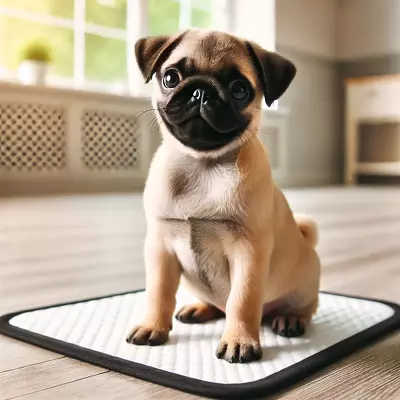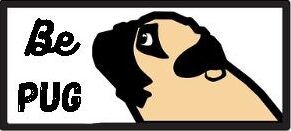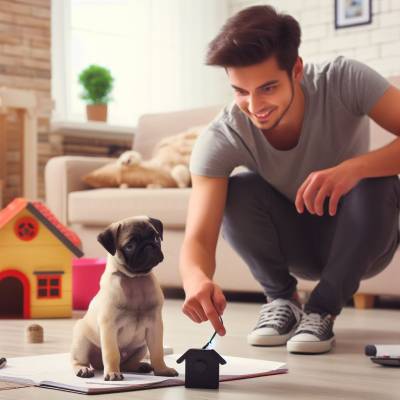Say Goodbye to Messes: Tips on How to Potty Train Your Puppy on a Pad

Potty training a puppy on a pad is a helpful way to teach your new furry friend where to go to the bathroom. This method is especially useful for those living in apartments or places without easy access to outdoor spaces. By using a pad, you can create a designated area for your puppy, making it easier to manage accidents and keep your home clean.
I. Introduction
A. Importance of Potty Training
Potty training is one of the most important steps in raising a puppy. It helps establish good habits and prevents messes in the house. Proper training also builds a bond between you and your puppy, fostering trust and communication.
B. Benefits of Using Pads
Using pads for potty training offers several advantages. Pads are convenient, especially if you live in an apartment or don’t have easy access to outdoor spaces. They provide a specific area for your puppy to relieve itself, reducing accidents around the house. Pads are also absorbent, which helps maintain cleanliness.
C. When to Start Training
The best time to start potty training is as soon as you bring your puppy home. Puppies learn quickly at a young age, and starting early helps instill good habits from the beginning. Consistency and patience are key during this period.
II. Preparing for Potty Training
A. Gathering Supplies
Before you begin, gather all the necessary supplies. You’ll need puppy pads, a crate, treats for rewards, and cleaning supplies for any accidents. Having everything ready will make the process smoother.
B. Choosing the Right Location
Select a spot in your home where you want your puppy to use the pads. This area should be quiet and easily accessible. Avoid high-traffic areas to minimize distractions.
C. Setting Up the Training Area
Set up the training area by placing the pad in the chosen spot. Make sure it’s securely in place. You should use a pad holder or tray to prevent it from moving. This setup creates a clear, designated area for your puppy.
III. Step-by-Step Guide to Pad Training
A. Introducing Your Puppy to the Pad
Start by showing your puppy the pad. Allow them to sniff and explore it. You can place them on the pad after they eat, drink, or wake up from a nap. These are common times when puppies need to go.
B. Establishing a Routine
Consistency is crucial. Take your puppy to the pad regularly, especially after meals, playtime, and naps. Praise them when they use the pad correctly. Over time, they will associate the pad with going potty.
C. Positive Reinforcement Techniques
Use positive reinforcement to encourage good behavior. Reward your puppy with treats and praise whenever they use the pad. This makes the experience positive and helps reinforce the habit.
D. Handling Accidents
Accidents will happen. When they do, clean the area thoroughly to remove any scent. Avoid scolding your puppy, as this can create fear. Instead, calmly place them on the pad to remind them where to go.
IV. Common Challenges and Solutions
A. Reluctance to Use the Pad
If your puppy is hesitant to use the pad, try placing it closer to their crate or play area. Gradually move it to the desired location. Patience and persistence are key.
B. Pad Chewing and Playing
Puppies sometimes chew or play with the pads. To prevent this, use a pad holder or tray. Provide plenty of toys and chews to keep them occupied and reduce the temptation to play with the pad.
C. Transitioning to Outdoor Training
Once your puppy consistently uses the pad, you can start transitioning to outdoor training. Gradually move the pad closer to the door and eventually outside. Praise and reward them for going outdoors.
V. Maintaining Good Habits
A. Gradual Reduction of Pad Use
As your puppy becomes more reliable, you can reduce the number of pads in the house. Start by removing one pad at a time and monitor your puppy’s behavior. Continue praising them for using the remaining pads.
B. Consistency and Patience
Consistency is key to maintaining good habits. Stick to the routine and be patient. Puppies may have occasional setbacks, but with continued guidance, they will improve.
C. Monitoring Progress
Keep an eye on your puppy’s progress. Note any patterns or challenges and adjust your approach as needed. Regular monitoring helps ensure successful potty training.
VI. FAQs
Q: How long does it take to potty train a puppy on pads?
A: It varies, but most puppies learn within a few weeks to a few months with consistent training.
Q: What should I do if my puppy refuses to use the pad?
A: Try placing the pad closer to its usual spots and gradually moving it to the desired location. Use positive reinforcement and be patient.
Q: Can I use pads and also train my puppy to go outside?
A: Yes, you can start with pads and gradually transition to outdoor training as your puppy ages and becomes more reliable.
Q: How often should I change the puppy pads?
A: Change the pads as soon as they become soiled to maintain cleanliness and encourage your puppy to use them.
Q: Is it normal for puppies to have accidents during training?
A: Yes, accidents are part of the learning process. Clean the area thoroughly and continue with consistent training.
Q: What type of treats should I use for positive reinforcement?
A: Use small, soft treats that your puppy loves. Please make sure they are suitable for puppies and given in moderation.
Q: How can I prevent my puppy from chewing the pads?
A: Use a pad holder or tray and provide plenty of chew toys to distract them from the pads.
Q: How much time does it typically take to house-train a puppy?
A: It varies, but most puppies learn within a few weeks to a few months with consistent training.
VII. Conclusion
A. Recap of Key Points
Potty training your puppy using pads involves setting up a designated area, following routines, and using positive reinforcement. Patience and persistence are essential throughout the process.
B. Encouragement for New Puppy Owners
Remember, every puppy is different. Stay positive and patient, and celebrate small successes along the way. Your efforts will pay off with a well-trained and happy puppy.
C. Final Tips for Success
Keep a regular schedule, be consistent with training, and always use positive reinforcement. Monitor your puppy’s progress and adjust your approach as needed. With time and dedication, your puppy will learn to use the pads reliably.
VIII. Suggested Readings
Reading about different training methods and experiences can provide valuable insights and additional tips. Here are a few recommended books:
- “The Art of Raising a Puppy” by The Monks of New Skete – This book offers comprehensive guidance on puppy training, including potty training techniques.
- “How to Housebreak Your Dog in 7 Days” by Shirlee Kalstone – A practical guide to housebreaking, with step-by-step instructions that can be adapted for pad training.
- “Puppy Training in 7 Easy Steps” by Zoom Room Dog Training – This book covers basic training, including potty training, with easy-to-follow steps.
- “Perfect Puppy in 7 Days” by Sophia Yin – A detailed guide to training your puppy, with a focus on positive reinforcement and building good habits.
These books can provide further insight and techniques to ensure your puppy becomes well-trained and happy. Reading widely can help you find the best methods that suit your and your puppy’s needs.






